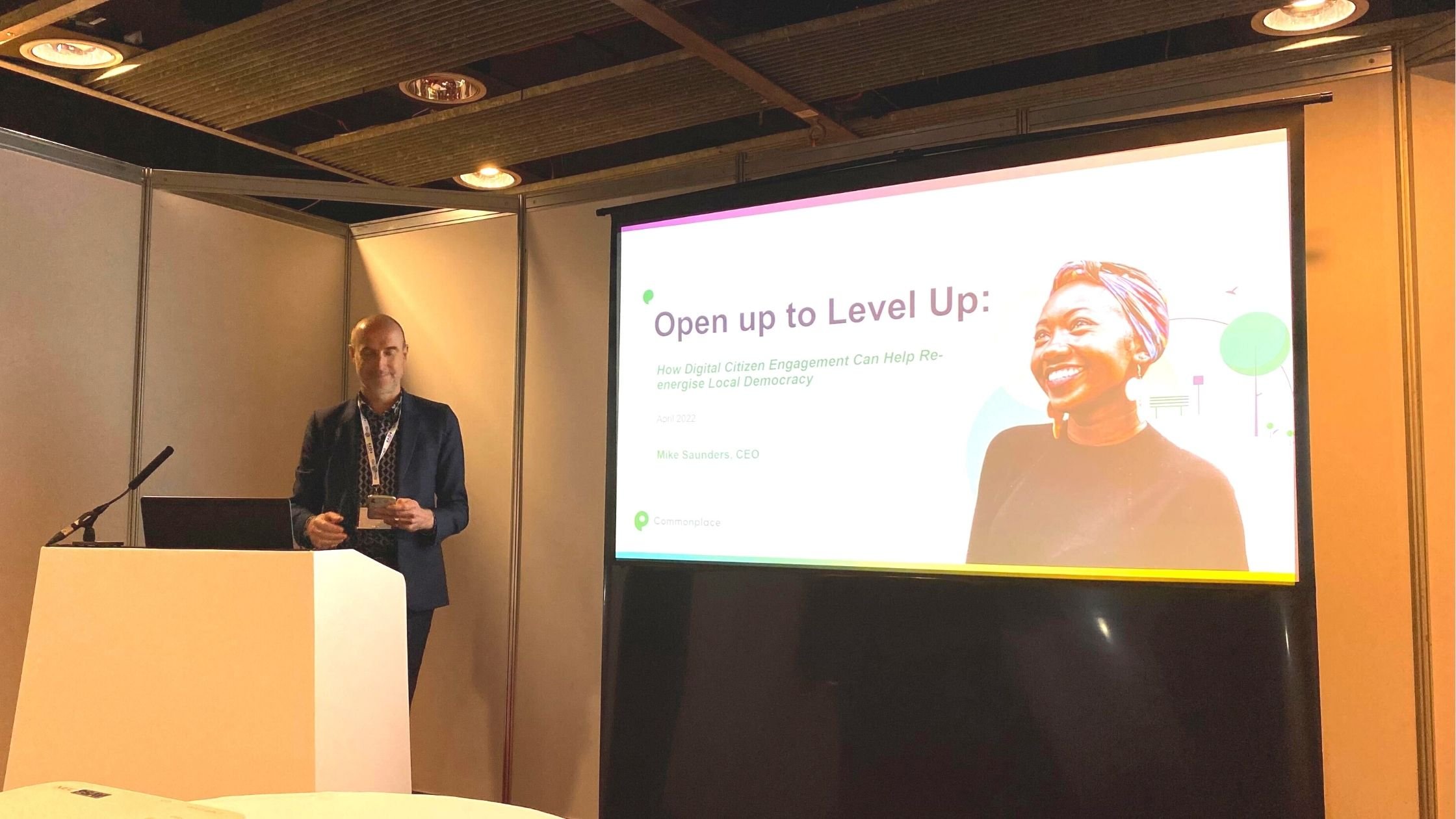Last week saw us pitching up our own exhibition stand at the UK’s largest local government procurement event - the Local Government Procurement Expo (LGPE): A day dedicated to buyers and suppliers within the local government marketplace, this was our day of meeting, greeting and listening!
Commonplace’s LGPE Summary:
Steps walked: 32,000
Talks attended: 5
Free sandwiches eaten: 4
Chocolates nibbled: 20+
We can all agree that the past two years have been some of the most challenging periods for local government in recent memory. The impact on local government procurement is clearly being felt by many authorities and those that supply them. Having the opportunity to meet in person for the first time since the beginning of 2020 has been a breath of fresh air and a great opportunity for buyers and suppliers to chat openly (while also picking up a few freebies from the exhibitors of course). While staffing the Commonplace, our team had the chance to chat with many local authorities, connect with other suppliers and listen to the agenda of speakers for the day which covered four main areas:
- Procurement Skills
- Technology and Innovation
- Social Value and Sustainability
- Bidding Support
Our very own Co-Founder and CEO Mike Saunders took to the stage for a talk about the need for better communication between local authority and citizens if the government’s levelling up agenda is to come to fruition.
Missed out on the event? Here is our LGPE catch up with all the highlights! Let’s dive in.
Highlight #1: Open up to Level Up, How Digital Citizen Engagement Can Help Re-energise Local Democracy

Mike’s session covered all the crucial talking points about giving local citizens the tools to engage and improve their local areas. He highlighted:
- One of the few good outcomes of the pandemic was the rise in unique digital platforms and solutions, changing the way that many of us communicate day to day- both with our friends and family as well as businesses and local authorities.
- The recent ‘Planning for the Future’ government white paper mentions the word ‘community’ 451 times. However you feel about the white paper’s proposals, it’s clear the central government wants the community at the heart of their plans. To make that happen, there’s a huge opportunity to open up a new dialogue using digital tools.
- Local democracy itself rests on a relatively infrequent vote, and communities have shown that they want the opportunity to have their voices heard between those votes and collaborate in a more continuous way. This is where a solution like Commonplace comes in. It’s more than just a checkbox platform for a consultation, it’s a digital hub for continuous citizen engagement.
- Over 5.0 million people have already engaged with us, partly because of the visual and delightful interactions that we provide on the platform. Interactive maps, snackable surveys and 3D rendered environments all help to make it clear what a community can do to shape the spaces around them.
“We’re a purpose-led organisation and our purpose is powering positive participation. We believe that collecting data from communities can help establish what their shared needs and priorities are. And then, by hosting an open and continuous conversation, we can help provide better collaboration which produces better outcomes.”
We can see this in all of our projects as well as our own research that we publish:
- From Brownfield to Green Space: Want to know how to successfully engage communities on brownfield site developments? Our latest research draws on 20 of our brownfield projects and 8,000 data points and is packed with trends, tips and recommendations.
- Community Engagement 101: In this free eBook, you'll find everything you need to know about how digital tools can help get communities on board with your plan for their neighbourhoods whilst getting you the data you need to create better solutions for your communities.
- Engaging for the Future: We present the findings of our public opinion polling, qualitative research and data collected across over 1,000 planning engagements on the Commonplace platform.
When it comes to Local Plans, our aim is to make the process as open and simple as possible for the community. The local planning process often involves a lot of technical language and rigid processes, where a more visual platform helps make the whole process much clearer. With maps that can have proposals overlaid, the process and outcomes become a lot easier to visualise and understand.
Highlight #2: Challenges facing Local Authorities Tackling the Climate Crisis: Helping the Public
.jpg?width=2240&name=CP%20LGPE%20(2).jpg)
A key theme of many of the talks given was how many local authorities are taking a more active role in facing the climate crisis head-on. This was discussed by Orbis Procurement and the Carbon Trust in one of the first talks of the day- covering how to help the public sector oversee emissions in their supply chain.
One key issue that was highlighted was that for all those in procurement seeking to fight the climate crisis, emissions from supply chains need to be assessed and tackled. However, the challenges on that front are vast and wide-ranging:
Strategic challenges: This is the thinking; the theorizing and knowing exactly where to start. With a problem as big and complex as the climate crisis, knowing exactly where to begin can be tricky. It also encompasses being able to set category specific approaches and to avoid greenwashing while also articulating the benefits of bringing others on this journey. The solution offered here? Clear and structured planning.
A broad baseline of the scope of emissions is needed to map out a path to net-zero. For example, Orbis mapped out their own scope of emissions and highlighted the highest: transit; waste management; residential care services, and maintenance services.
Operational challenges: This is how we can do what we need to tackle these issues, especially on the (often limited) local authority budgets. Also, how it can be done constantly and how operational infrastructures can be built to make sure that these plans are set up for success.
Here, cost especially can be a roadblock to progress, namely how much it will cost at the outset to make a difference.
Delivery challenges: What are the contracts that need to be drawn or suppliers to be used to help curb emissions? And how do we measure this?
Here, what needs to be considered is how much a supply chain can actually absorb in terms of carbon reduction requirements without impacting service delivery. This all comes down to clear data analysis - being able to see exactly where emissions are coming from, where improvements can be made and that each member of the supply chain is reporting in the same way.
It’s only by considering all of these broad themes that progress can be made. According to the live poll ran at the talk, the biggest challenge to collaboration was ‘Understanding and supporting SME capacity and capability.’ Three key answers were offered.
Collaboration: Working at the ‘highest’ level possible to integrate supply chain management processes. This can help with the following two points especially.
Data management: Exchange and management of carbon data and improved accuracy.
Procurement: Improve processes in the evaluation of requirements, contract management etc.
Highlight #3 Kerbside Charging in Cites to equal cope with the growth of Electric Vehicles- Crown Commercial Service
.jpg?width=2240&name=CP%20LGPE%20(1).jpg)
Several talks within the “Social Value and Sustainability” Zone touched on another hot sustainability topic within local authorities: the proliferation of electric vehicles. Given the government’s recent announcement that it will support a tenfold expansion of the electric vehicle charging points in the next eight years, we’ve been keeping one ear very close to the ground around this topic and couldn’t wait to see what the experts had to say. The lead researcher for environment and sustainability at Crown Commercial Service discussed the future of kerbside charging and the sustainability benefits of introducing kerbside charging.
Recently, the government has taken some historic steps towards net-zero by announcing that they will stop the sale of new internal combustion-powered cars by 2030. By 2035, all new cars and vans on sale will be fully zero emissions at the tailpipe 5. The charging infrastructure is expanding to match - there has been a 33% increase in the number of EV charging spots since March 2021.*
So how does this affect the reduction of emissions by local government suppliers? One option is replacing the existing fleet of vans with EV vehicles. While a simple-sounding solution, there are logistical hurdles to overcome first- mostly around charging these vehicles. For example, if a large portion of the workforce lives in flats or terraced housing, there’s often little parking so no space for traditional EV chargers. It would also be unfair to ask every driver to sit for an hour every evening at their nearest public charging point.
This is where new lamppost charging comes in. Unlike traditional EV charging points that take up parking spaces in supermarkets or are attached to the garage in a residential property, these blend directly into lamposts or the pavement. This makes them a better solution for those without car parks and allows vehicles to be left plugged in overnight, Plus, since EV drivers have their own cable, there are no cables dangling at the streetside causing a potential trip hazard. They also use existing infrastructure, negating the need to build new areas for these chargers. (However, local authorities will need to enforce the use of these bays - at the moment, in most places, it is legal for non-EVs to occupy spaces by lamppost chargers).
We’ve seen the popularity of lamppost chargers ourselves with Greenwich’s lamppost charging consultation. The local council is currently trialling lamppost charging throughout the borough and asked citizens to drop a pin on a map where a charging point would be most useful to them. This led to over 150 contributions in total showing the desire for a stronger EV charging infrastructure in the area.
.png)
